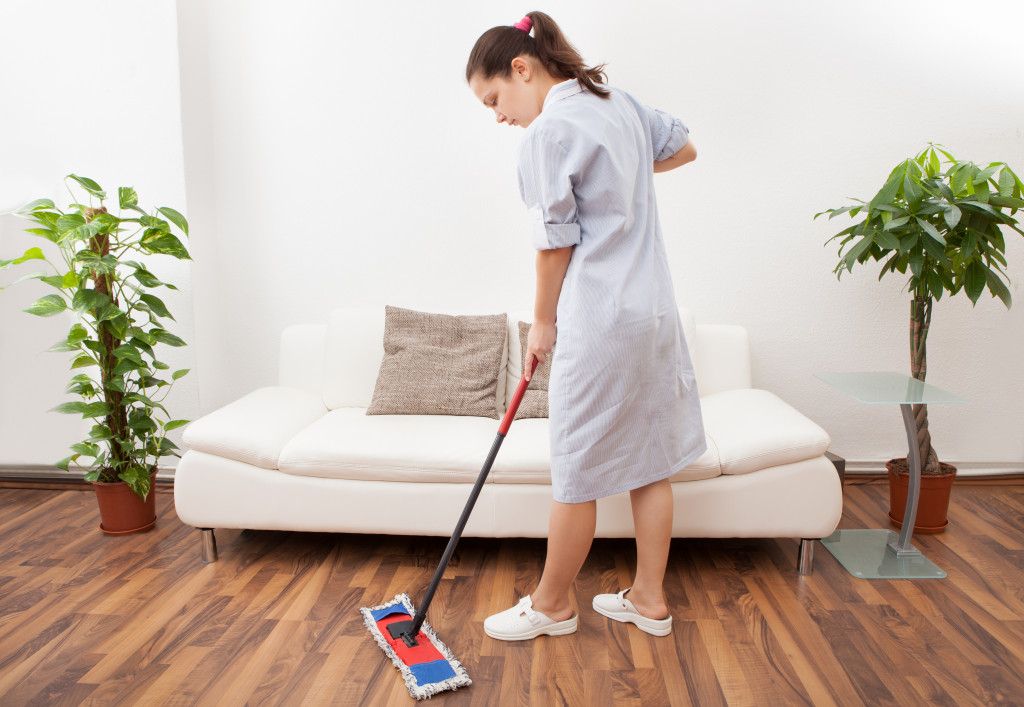One of the most daunting parts of cleaning the house is cleaning the many kinds of floors in different rooms. There is quite literally a lot of ground to cover, so you want to be efficient in how you go about the chore.
It may seem as simple as just vacuuming and mopping, but this is hardly ever the case. Not all floors are made the same way. That means they also require various cleaning techniques for the best results.
Different Material, Different Methods
First, you have to know what kind of floors you are dealing with. Knowing what you’re up against will help you have the best plan to deal with the dirt on your floors.
1. Hardwood Floors
Hardwood flooring can be tricky, as some kinds could be damaged by water, while others can handle water cleaning. Before touching the floor with any cleaning product, do your usual dusting, sweeping, and vacuuming.
Also, find out if your hardwood floors are treated or not. Drop little bits of water on it, then check if it stays on the floor (sealed) or if it is absorbed (unsealed). This will tell you if they can handle cleaning with water.
For instance, white oak engineered hardwood is one kind that is durable through water exposure. Waxed hardwood floors, on the other hand, should not get wet. You can tell if your hardwood floors have a wax finish by rubbing your finger on them and seeing if it forms a smudge or not. Smudges mean they are wax-finished.
For water-safe hardwood, use a mop with mild soap and water. If your floors are waxed or untreated, just dust, vacuum, and/or sweep.
2. Ceramic Floors
If your house has primarily ceramic flooring, then good news: cleaning is a much simpler matter. You can usually manage with a soap or detergent solution when mopping these floors.
However, there are times when stains and dirt can dull your tiles and the grout. Hydrogen peroxide is a useful option for scrubbing out marks.
Grout stains, on the other hand, can disappear through grout cleaners and bleach solutions. If the dirt sits particularly deep, feel free to let the solution sit for 10 minutes before rinsing. After you have removed pesky stains, mop the floor and let it dry.
3. Vinyl Flooring

Remove dust and dirt particles from vinyl floors by sweeping or vacuuming. You can then use a mild detergent solution to mop your floors and remove any stains.
Vinyl usually requires simple cleaning measures, but it takes a bit more care to make sure it sustains no damages from your everyday activities. Do not drag heavy furniture across your vinyl floors to prevent scratches. Also, don’t use a steel wool sponge to remove tough stains, as these can damage vinyl.
4. Laminate
After doing your routine dusting, use a slightly damp cloth or mop to clean laminate floors. Pass on the detergent and soap for this one, as they could leave a slippery film on the floor.
If you need to remove light stains, a mixture of water and vinegar should do. For deeper stains, acetone will usually do the trick.
5. Cork Floors
Cork floors are porous, but they are usually sealed. It is best to be on the safe side when it comes to this kind of flooring, though, so vacuuming should be your usual routine.
Do not use overly wet cloths, sponges, or mops to clean cork. If necessary, use a slightly damp mop or spray a mixture of water and vinegar on your floors before mopping to remove dirt on the floor.
As with linoleum and vinyl flooring, avoid damage when carrying heavy furniture over these floors.
6. Stone Floors
The biggest concern with stone floors is that they stain easily. If you accidentally spill something on them, immediately wipe up the liquid to keep it from seeping into the flooring.
There are many stone-friendly cleaners in the market that you can use with a mop to clean up stains. Avoid harsh ingredients such as bleach, ammonia, and vinegar, which can damage stone.
Keeping the Dirt Away
The daily traffic of your household naturally allows all that dust, dirt, and grease to build up in your home. The keys to easier cleaning are to think ahead and not to delay.
Place mats on your floors to avoid scratches caused by heavy equipment. Keep shoes in a rack outside your living space. Do spills or stains occur? Wipe them up immediately.
Cleaning is a much simpler job when you prevent problems from happening rather than try to solve them.

